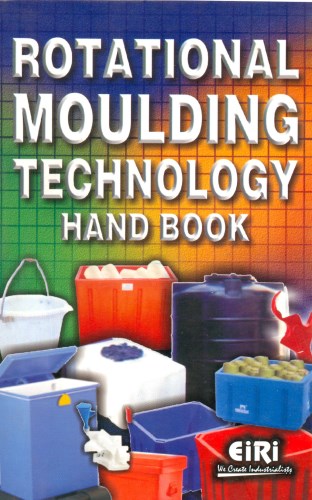Description
ROTATIONAL MOULDING TECHNOLOGY HAND BOOK
Innovative Rotomoulding
Technology of Rotational Moulding
- Moulds
- Types of moulds
- Materials
- Machines
- Shuttle Machine
- Carrousel
- Rock and Roll
- Product design
- Design considerations
- Parting Lines
- Fill port for Loading
- Drop Boxes
- Shrinkage
- Flatness and Stiffening
- Radiuses and Angles
- Venting
- Wall Thickness
- Spiders for Mounting
- Recent improvements in rotational moulding
- Quality control in rotational moulding
- Coating and Release Systems
- Advantages
- Low Pressure Process
- Unlimited Design Possibilities
- Cost Savings
- Rotational moulding vs blow moulding cost comparison
- Shorter Production Times
- Consistent Wall Thickness
- Disadvantages
- Applications
- Transportation Products
- Industrial and Commercial
- Agricultural
- Construction
- Industrial Products
- Marine Products
- Playground Equipments
- Recreational Products
- Electrical/Electronics
- Parts manufacturers using rotational moulding techniques
- Little Tikes
- Low and Bonar
- Gallery of rotomoulding products
- Toter
- The Future of Rotational Moulding
Rotational Moulding Process
- The process
- Machine designs
- Material mania
- A Complete Life
- Process set up
- Design recommendations
- Holes
- Design of the ribs
- Bosses
- Kiss off
- Wall Thickness
- Flat Surfaces
- Surface Finish
- Tolerances Possible
Roto moulding Technology Details
- Advantages of Rotomoulding
- Disadvantages of Relational Moulding
Materials that can be Roto moulded
- Characteristics of material for roto moulding
- Polyolefins
- Effects of increase in melt flow indecks
- Vinyl plastics
- Other plastics
- Reactive materials
- General information
- Environmental Stress Cracking (ESC)
Roto moulding Machines
Design Consideration for Roto mould Containers
- Rotationally moulded plastic part design
- Wall Thickness
- Wall thickness Uniformity
- Closely Spaced Parallel Walls
- Warpage
- Stiffening Ribs
- Kiss-off Ribs
- Draft Angles
- Surface finish
- Undercuts
- Holes
- Corner Radii
- Tolerances
Rotational Moulding Process Control
- Principles of process control
- Effect of mould material
- Effect of part thickness
- Control of part properties
- Impact strength
- Bubble count
- Processing advantages
- Mould balancing
- Additives
- Machine Improvements
- Quality control
Rotational Moulding of Nylons
- Applications of nylon
- Nylons suitable for rotomoulding and modifications
- Machine considerations
- Machine Type
- Inert Gas Injection
- Methods of Rotomoulding Using Nitrogen
- Moulds and mould release coatings
- Moulds
- Mould release coatings
- Moulding conditions
- Charging the mould
- Heating cycle
- Cooling cycle
- Properties of moulded nylons
- Effect of plasticizer
- Effect of moisture
- Thermal considerations
Moulds Fabrication for Roto moulding
- Complexity of form
- Quantity of moulds required
- The appearance of the product surface
- The cost of the mould
- Parting Line
- Methods of Construction
- Inserts
- Special Features
- Clamps and Clamping
- Finish
- Constructional features of the mould making
- Parting Line
- Method of Construction
- Clamping
- Inserts and cores
- Fixed inserts
- Interchangeable Inserts
- Removable Inserts
- Removable Threads
- Incorrect Pitching
- Thread shear
- Distortion
- Removable Handless
- Moulded in Holes
- Moulded in Inserts
- Surface Finish
- Special features
- Heat Inducement
- Heat exclusion
- Kiss Points
- Charge hoppers (Drop Box)
- Venting
- Mounting
- Maintenance
- Areas for Attention
Roto moulds for Cast Aluminium
- Product design
- The pattern
- Mould design
- Parting Lines
- Removable Cores
- Ribs or “Kiss-Off”
- Moulded inserts
- Surface finish
- Number of pieces
- Function and operation of mould
- Farming
- Spiders
- Clamping devices
- Heat transfer
Pin holes and Bubbles in Roto moulded Products
- Bubble formation
- The effect of the moulding material on bubbles
- Melt Rheology
- Viscosity reduction techniques
- Powder characteristics
- Mould considerations
- Mould surface finish
- Mould material
- Mould Hot spots
- Bubble removal using pressure
- Pressurized rotational moulding
- Mechanical properties
- cycle time
- Product thickness
- Moulding material
- Using pressure as a blowing agent
- The use of a vacuum to remove bubbles
- Effect of pressure and vacuum on the mould
Rotational Moulding of Liquid Polymers
- Advantages to be gained when moulding liquid polymers
- Materials for liquid polymers
- Moulding equipments for rotomoulding liquid polymers
- Material Handling
- Moulds
- Some recommendations for the rotational moulding of liquid Polymers
Powdering Thermoplastic and Quality Consideration
- The quality of powder
- Particle size and distribution test (ASTM D 1921)
- Dry Flow Test (ASTM D 1895)
- Builk density test (ASTM D 1895)
- Characteristics and their effect on moulding
- Particle size
- Particle shape
Plastic Water Storage Tanks (HDPE) (Sintex Type)
- High Density Polyethylene
- Polypropylene
- Poly Vinyl Chloride
- Process of manufacture
- Plant economics
- Plant and Machinery
- Fixed capital
- Raw materials
- Total working capital/month
- Total capital investment
- Turn over/annum
Suppliers of Plant and Machinery of Roto Moulding and Moulds
Engineers India Research Institute (EIRI) is a renowned name in the industrial world for offering technical and financial consultancy services.
EIRI services are:
- Detailed Feasibility Reports
- New Project Identification
- Project Feasibility and Market Study
- Identification of Lucrative Industrial Project Opportunities
- Preparation of Project Profiles / Pre-Investment and Detailed Feasibility Studies,
- Market Surveys / Studies, Market Survey Cum Detailed Techno-Economic Feasibility Reports
- Project Reports in CD Roms
- Identification of Plant /Process/Machinery and Equipment, Industrial General Guidance for setting up new industrial projects.
Our most up-to-date and Technologically Advanced Industrial Project Reports, categorized with respect to Financial Outlays and Sector – wise Classification are immensely useful for :
- Existing Small or Medium Scale Industrialists facing competition from large houses
- Young Entrepreneurs dreaming to start their own industrial enterprise
- Young Graduates and Professionals wishing to begin their career
- Industrialists interested in Debottlenecking their capacities & New Product – Lines
- Large Industrial Houses pursuing Expansion, Growth and Diversification Plans




